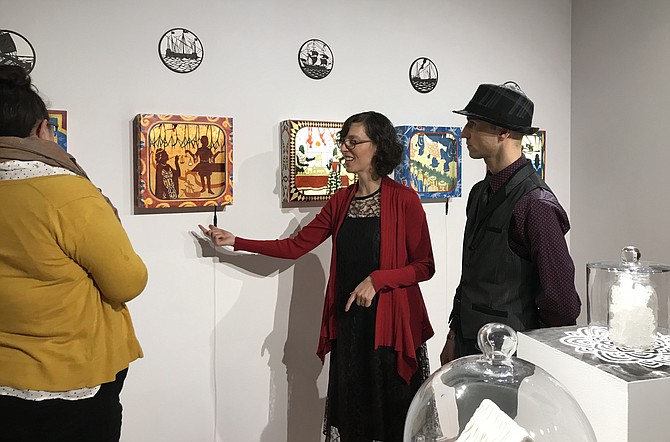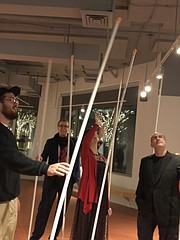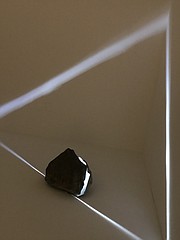Artist Melanie Kehoss explains her work to patron Jennifer Biehl as Kaveh Jorab looks on during the opening of the exhibit, “Mary B. Howard Invitational: Stretch,” now through Feb. 9, 2019. Photo by Mercia Hobson.
Given an unprecedented bequest by longtime GRACE board member, the late Mary B. Howard of Reston, the Greater Reston Arts Center (GRACE) created an invitational to promote new works by artists in the community. Artists were asked, "If you could do anything, what would that be?”
Five artists stretched their imaginations, resources and materials to create the current exhibit that runs through Feb. 9, 2019. Howard also recognized diversity in the voices of curators so for this exhibit, GRACE invited Don Russell, university curator and director of the Provisions Research Center for Art & Social Change at George Mason University to help the students.
Five artists, James Huckenpahler, Monroe Isenberg, Katie Kehoe, Melanie Kehoss and Harry Mayer, stretched the boundaries of their art to create works dealing with endurance, humor and intellectual curiosity for the "Mary B. Howard Invitational: Stretch."
Melanie Kehoss created colorful light boxes displaying intricately cut paper, plexiglas, wood, gouache and LEDs. "Each box depicts an era in the history of sugar," said Kehoss. The detail work and unusual presentation draw the viewer in questioning what one is seeing.
Harry Mayer used common building materials such as steel bars, PVC piping and concrete and even whimsical rubber finger puppets to as he said, ”make something that was a hassle." In the catalog, Mayer encapsulates the meaning of his art in these words, "endurance, fortitude, acceptance and tolerance … The pieces serve as silent markers of problem solving and struggles."
A third artist, Monroe Isenberg, presented a stone and woodwork illuminated sculpture that sits on the floor. Light radiates out of a sandwich-like split in the stone, beaming across the floor from both sides and up into one corner of the room forming a triangle — the minimal and abstract shape framing the space, altering it.
Two other artists exhibited their works. Katie Kehoe showed a documentary from her series of 18 performance actions that involved her wearing a wetsuit, carrying a boogie board and walking 91 miles through areas that would, "be flooded if the sea level was to rise above six feet," as she described.
The fifth artist, James Huckenpahler, produced contrasting, black and white digital prints on Dibond.
GRACE is located in Reston Town Center at 12001 Market Street, Reston.


